On a warm morning in March, 100-odd residents of Manavseva Project, a shelter home at Arangaon, 11 km from Ahmednagar town in western Maharashtra, are out in the open, basking in the bright sunshine after breakfast. Built on a two-acre plot, the home is surrounded by fields of jowar, bajra, wheat, soyabean, and groundnut. Visitors must make their way through narrow kuccha pathways in the middle of the fields to reach the home run by Shree Amrutvahini Gramvikas Mandal, an NGO founded by Dilip Gunjal.
Among the residents are men and women rescued by the State police after they were lured by traffickers or contractors with the promise of work with good pay and food, but forced into bonded labour. Siraj Shaikh, administrative officer of the NGO, says the shelter home is the only refuge for rescued bonded labourers in Ahmednagar. He says most of them are not able to communicate well as they are still recovering from the trauma of living in inhumane conditions, and being beaten, bound, drugged, and forced into working for long hours with little food or water.
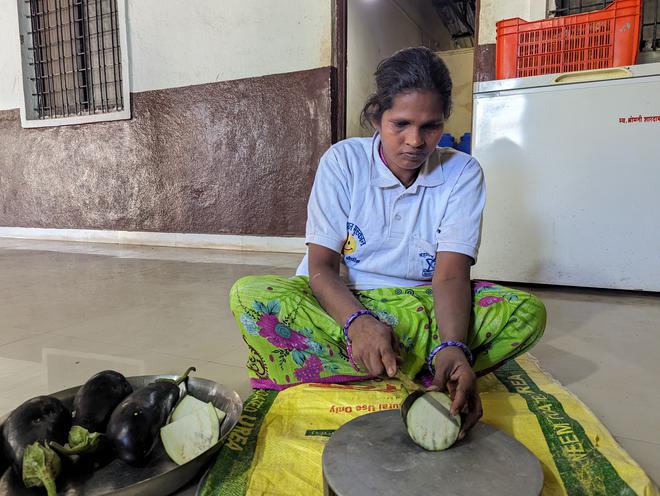
Mukta (name given by the NGO) offers a hug and a handshake. However, she finds it hard to speak and is unable to tell how old she is or the place she hails from. She starts gesticulating, cries out, and points to her tongue. Shaikh says the police suspect that her captors applied lead oxide or shendur (Marathi word for vermilion) on the tip of their tongue as part of their harsh methods to squeeze out more work from her, causing speech impairment. “Since she does not know how to communicate using sign language, it has become challenging to understand her. She does not even know how to read or write,” he says.
Mukta is one of the 23 people rescued by the Belvandi police from farms in Ahmednagar district since May 2023. Hailing from places such as Chandigarh, Chhattisgarh, Uttar Pradesh, Bihar, Tamil Nadu, Telangana, Karnataka, Odisha, West Bengal, and Maharashtra, none of them could speak at the time of rescue as they were numb and disoriented after being drugged by their captors with narcotics like cannabis, the police say.
Recently, four survivors were rehabilitated and reunited with their families: Lalan Sukhdev Chaupal, 61, from Samastipur, Bihar; Dattatray Nagnath Karale, 58, from Solapur, Maharashtra; Mansur Ali, 48, from Sitapur, Uttar Pradesh; and Bhaiyalal Morya, 32, from Basti village, Uttar Pradesh. The police say Karale went missing from his home 25 years ago and only his wife was able to recognise him after he was rescued. Traffickers sold him from one place to another within Maharashtra — Mumbai, Pune, Latur, and Ahmednagar — for ₹2,000-₹8,000, and forced him to beg, work in sugarcane fields, and dig wells.
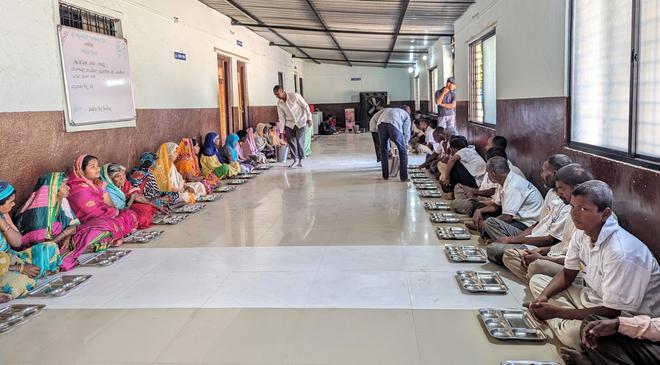
‘Low reporting of cases’
According to December 2018 data from the Union Ministry of Labour and Employment, of the 3.13 lakh bonded labourers rehabilitated in the country, 1,404 were from Maharashtra. The top three States on the list were Karnataka (66,281), Tamil Nadu (65,573), and Uttar Pradesh (42,279).
However, NGOs, the police, and activists on the ground say not many cases of bonded labour are reported in Maharashtra owing to lack of awareness of this form of modern slavery, which has been illegal in India since 1976, when the Bonded Labour System (Abolition) Act came into force. Section 2 (g) of the Act defines bonded labour as “the system of forced, or partly forced, labour under which a debtor enters, or has, or is presumed to have, entered, into an agreement with the creditor”. The National Crime Records Bureau data show that only four cases of bonded labour were reported in Maharashtra in 2022.
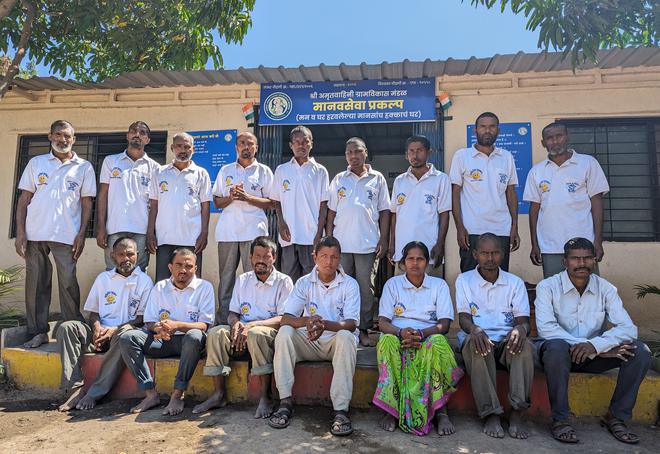
Police Inspector Sanjay Thenge, who joined the Belvandi police station in 2023, says the prevalence of bonded labour in the district’s Shrigonda taluka came to light during an investigation into an unclaimed body found stuffed in a gunny bag in a well. Police records spanning 10 years showed that there were 71 reported cases of unidentified bodies disposed of in a similar manner in the taluka. The sacks were retrieved from wells only when they raised a stink, he says.
“On May 2, 2023, another body was found in a well. Since it had not yet decomposed, a post-mortem was conducted and the report revealed heart attack as the cause of death. Investigation showed criminals in the area had been trafficking people from across India and pushing them into bonded labour in fields or begging at religious and public places in Mumbai and Pune. If one of them died, of natural causes or torture, the body was stuffed into a gunny bag and dumped into a well. This was done to divert the police investigation into tracing the dead,” says Thenge.
Based on a tip-off, he raided four locations in the taluka and freed six bonded labourers. “All of them were malnourished, drowsy, with unkempt hair, cracked skin, soiled clothes, and fungal infection on their feet. The accused told us that they engaged the bonded labourers in harvesting sugarcane from September to April in the district and sent them for begging in Mumbai and Pune during the holiday and festival seasons. They were also made to work on agricultural or dairy farms, at construction sites, or dig wells. So far, 21 traffickers, 19 men and two women, have been arrested and prosecuted,” says Thenge, who was recently transferred to the Rahuri police station.
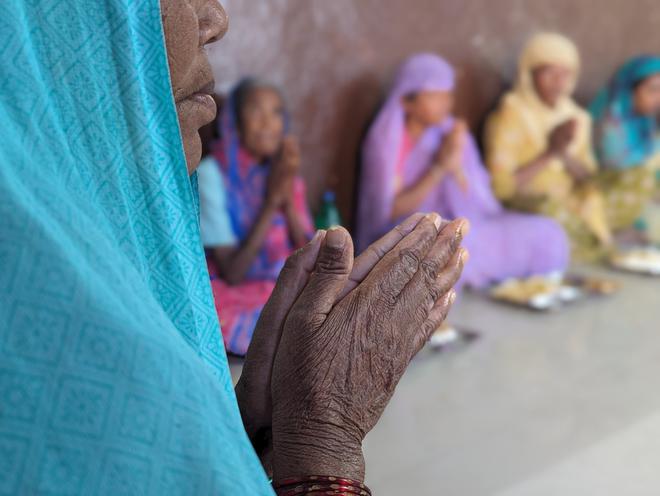
Following the rescue, the police approached Gunjal’s NGO as the government shelter home for survivors of human trafficking and bonded labour is in Yerawada Central Jail, Pune, and it is inconvenient to travel three hours by road every time there is a court hearing in the trial, which might take months or even years to conclude. Else, the survivors have to remain in the police lock-up. “For entry into our home, we only need a medical certificate and a letter from the police stating the requirement of shelter,” says Gunjal.
Stricken with fear
Each rescued person has survived extremely traumatic situations, affecting their mental health, says Dr. Suresh Vilas Gholap, medical officer at the NGO. “They were scared and would not look up or meet our eyes; some were trembling with fear. All of them had skin diseases owing to prolonged stay in unhygienic conditions. Our mental health expert is helping them slowly gain confidence to speak. It is evident from their mental and physical condition that they were under the influence of drugs,” Dr. Gholap says.
Several survivors like Karan Kumar, 21, are not in a state to completely recall how they ended up in bonded labour. A native of Bhainso village in Chhattisgarh’s Janjgir-Champa district, he initially says he walked from his village to Maharashtra with a bunch of friends, and then states that someone took him and a bunch of boys in a truck and brought them to the Hyderabad railway station. After being forced to beg there for a few days, they were brought to Mumbai, then Pune, and finally Ahmednagar. The police say he was rescued on May 2, 2023 from Shrigonda taluka after arresting a trafficker named Pilaji Bhonsle.
“My life was better in Chhattisgarh; at least I had good food to eat and clothes to wear. These people (traffickers) drugged me and didn’t give a decent toilet or a bed. Bhonsle beat us often and mixed a pill in our food, which was one bhakri (unleavened flatbread made of jowar or bajra) and chilli chutney, or rice and chilli. After the meal, we would not feel hungry and were made to work continuously without breaks to sleep or even use the toilet. I have done all kinds of jobs — harvesting sugarcane, begging in different cities, digging wells, loading and unloading goods from trucks, cutting grass, collecting cow dung in farms... all without any pay,” says Kumar.
Sidheshwar Mahendranath Roy, 40, from Jalpaiguri district in West Bengal, who was freed from the captivity of his trafficker, Dalkhush Mukida Kale, on December 18, 2023, too can’t clearly remember how he reached Ahmednagar. “I left my home 27 years ago. We had two acres of farmland where we would grow paddy and eggplant. We are a nine-member joint family. These men who kept me in captivity were monsters. They would beat me, mess with my head by giving me some narcotic substances, and keep an eye on me even during toilet breaks. I did not take a bath for months until I was rescued.”
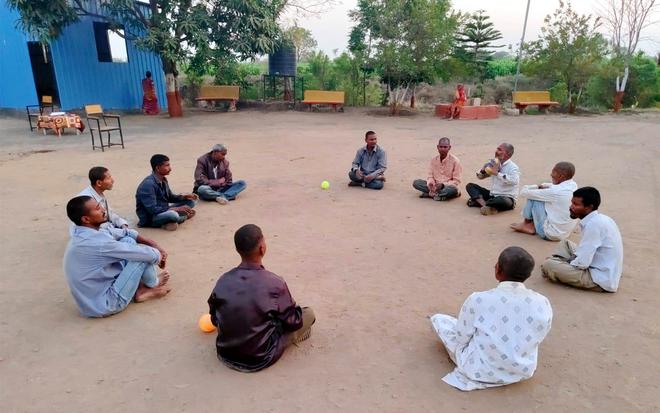
Reconnecting with family
Grappling with poverty, the family of Chaupal, from Singhia village in Bihar, had sent him with a trafficker, who gave an advance of ₹2,000 and promised work. Choupal says he was taken to Gujarat, where he had to load and unload heavy sacks. One day, he collapsed in a truck out of sheer exhaustion, hunger, and dehydration. On regaining consciousness, he found himself at the Hyderabad railway station. “I hadn’t eaten for three days. A person offered me food, water, and work, so I went with him.” He was then sold to another trafficker for ₹3,000 and brought to Mumbai to beg at traffic signals and railway stations. At times, he was also engaged as a labourer at construction sites. The police rescued Choupal on May 4, 2023 from Ghotavi village in Shrigonda taluka after they arrested Prem Amol Bhonsle, a trafficker who had bought him for ₹5,000. Chaupal was reunited with his family, but some survivors haven’t found the same acceptance.
“Will you please convince my wife and sons to accept me and take me back home?” says Bhausaheb Haribhau More, 41, from Chanai village in Maharashtra’s Beed district, who was brought by a mukadam (contractor) to work in the sugarcane fields in Ahmednagar around a year ago. “I was made to work from dawn to dusk without a toilet break and just two-three hours of sleep in a makeshift hut made of plastic sheets that collapsed with the slightest breeze. I had to sustain myself for a day with just dry bhakri and crushed chilli. It was strange that I would not get tired for hours or feel any exhaustion after the meal. They used to mix something with the chilli paste that would make me feel energetic throughout the day without even having to drink water.”
Shaikh says More’s captors, Ashok Bhonsle and Jangya Kale, have been arrested, and the NGO is trying to counsel his family to accept him. “They see him as a burden, but we are telling them that he can do small jobs and secure aid from the government to restart his life,” he says.
Struggle for compensation
Those rescued from bonded labour are entitled to compensation ranging from ₹1 lakh to ₹3 lakh under the Central Sector Scheme for Rehabilitation of Bonded Labourer, 2021. An immediate aid of ₹30,000 is to be provided after an FIR is registered and bonded labour release certificates are issued by District Magistrates or Sub-Divisional Magistrates. The remaining amount is provided once the case is settled in court. Though all freed workers at the shelter home have secured release certificates, most of them haven’t received any aid yet. “We have reached out to the district administration multiple times. The problem is that none of them have identity proofs to open a bank account. We are going to apply for their Aadhaar cards. The District Collector has issued a letter to fast-track the process,” says Gunjal.
The initial aid is not issued in most cases, says a Mumbai-based lawyer, who did not wish to be named. “Full compensation also takes time as it is not given until the accused is convicted. There is a corpus with the district administration that can be used to provide the initial compensation.”
The lawyer adds that most of the rescued bonded labourers do not have identity proofs as they might have left them behind at home or they were confiscated by the traffickers and contractors. “This is why the release certificate becomes a very important document. It has the photo of the survivor and other details. Often, the district administration fails to understand the importance of it and takes longer to issue the certificate. It can also be shown at the local police station when the survivors return to their hometowns and used to seek protection as there is always a chance that the traffickers will attempt to force them back into bonded labour.”
Questioned on the struggle to get aid, a source in the State Labour Department cites the example of 24 bonded labourers, in the eight to 25 age group, rescued from Nashik in 2022. “None of them had any documents. With the District Collector’s help, we held a camp and got them Aadhaar cards, bank accounts, release certificates, and the initial aid of ₹30,000. All of them were rehabilitated and reunited with their families.”
Under the Central scheme, a State government is required to conduct a survey of bonded labourers at the district level once every three years, with ₹4.5 lakh set aside for the purpose. In addition,10 lakh is allotted for conducting awareness programmes and ₹1.5 lakh for carrying out up to five evaluatory studies every year for eradicating bonded labourer. However, the source at the Labour Department says they are understaffed and do not get any grants to carry out such programmes.
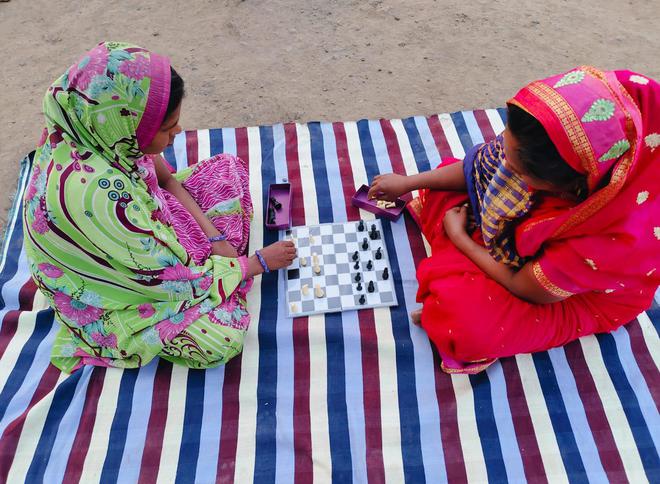
Getting back on their feet
Efforts are in progress to rehabilitate the rescued workers, says Mathura Jadhav, a volunteer at the home. “We have a set routine. At 6 a.m., they practise yoga. Some of them have now learnt to maintain their personal hygiene. At 8 a.m., they have breakfast. At 1 p.m., lunch is served. Then they rest till 4 p.m. In the evening, they play games and then watch a light-hearted movie on TV. These activities are slowly helping them open up, smile, and regain trust in people.”
Once they are able to carry out basic chores on their own, vocational training will be imparted, says Shaikh. He adds that another NGO, Pratham, has been conducting free skill development workshops for all the residents of the home. “They teach tailoring, housekeeping, beautician courses, and cooking. Recently, seven women residents secured employment as housekeeping staff and nursing assistants,” says Shaikh.
Manavseva Project is completely reliant on donations, says Gunjal. “If the voluntary contributions stop, then we will be able to run the home for a maximum of six months with our personal funds. After that, we will have to shut down.”







